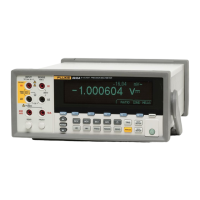8845A/8846A
Users Manual
1-4
About this Manual
This is the Users Manual for the 8845A and 8846A Digital Multimeters (hereafter
referred to as the Meter). It contains all of the information a new user will need to operate
the Meter effectively. The manual is divided into the following chapters:
Chapter 1 “Introduction and Specifications” provides information on how to safely
use the Meter, standard and optional accessories, and specifications.
Chapter 2 “Preparing for Operation” provides information on setting the Meter’s line
voltage, connecting it to a power source, and turning the Meter on.
Chapter 3 “Front Panel Operation” introduces the controls and connections on the
front and rear panels of the Meter.
Chapter 4 “Making Measurements” provides detailed information on using the Meter
to make electrical measurements.
Appendices
Safety Information
This section addresses safety considerations and describes symbols that may appear on
the Meter or in the manual.
A Warning statement identifies conditions or practices that could result in injury or
death.
A Caution statement identifies conditions or practices that could result in damage to the
Meter or equipment to which it is connected.
XW Warning
To avoid electric shock, personal injury, or death, carefully read
the information under “Safety Information” before attempting to
install, use, or service the Meter.
General Safety Summary
This instrument has been designed and tested in accordance with the European standard
publication EN 61010-1:2001 and U.S. / Canadian standard publications UL 61010-1A1
and CAN/CSA-C22.2 No.61010.1. The Meter has been supplied in a safe condition.
This manual contains information and warnings that must be observed to keep the
instrument in a safe condition and ensure safe operation.
To use the Meter correctly and safely, read and follow the precautions in Table 1-1, and
follow all the safety instructions or warnings given throughout this manual that relate to
specific measurement functions. In addition, follow all generally accepted safety
practices and procedures required when working with and around electricity.
CAT I equipment is designed to protect against transients from high-voltage, low-energy
sources, such as electronic circuits or a copy machine.
CAT II equipment is designed to protect against transients from energy-consuming
equipment supplied from the fixed installtion, such as TVs, PCs, portable tools, and other
houseshold appliances.

